
Self-portrait of Raphael with an unknown friend
This year the world is celebrating the 500th anniversary of Raphael’s death with exhibitions in London at both the National Gallery and the Victoria and Albert Museum, in Paris at the Louvre, and in Washington D.C. at the National Gallery. However, the mega-show, to end all shows, is “Raffaello 1520-1483” which opened on March 5th and is on until June 2 in Rome, where Raphael lived the last 12 years of his short life.
Since January 7th over 70,000 advance tickets sales from all over the world have been sold and so far there have been no cancellations in spite of coronavirus. Not only is Rome an appropriate location, but so are the Quirinal’s scuderie or stables, as the Quirinal was the summer palace of the popes, then the home of Italy’s Royal family and now of its President.
On display are 240 works-of-art; 120 of them (including the Tapestry of The Sacrifice of Lystra based on his cartoons and his letter to Medici-born Pope Leo X (reign 1513-21) about the importance of preserving Rome’s antiquities) are by Raphael himself. Twenty-seven of these are paintings, the others mostly drawings.
Never before have so many works by Raphael been displayed in a single exhibition. They are on loan from 55 different private collections and museums: The Louvre, London’s National Gallery and Royal Collection HM Elizabeth II, Madrid’s Thyssen-Bornemisza and Prado, Washington D.C.’s National Gallery, The Metropolitan, Florence’s Palazzo Pitti, Rome’s Palazzo Barberini and Villa Borghese, to name just a few. Several are returning to Rome for the first time since their creation there.
The most generous lender is the Uffizi in Florence with 49 works-of-art, mostly drawings. “Only ten of the Museum’s 21 Raphael canvases, since 2018 on display in ‘a room of their own’ with works by Michangelo and Leonardo, have been loaned, but visitors who’ve seen ‘Raffaello’ will receive a 33% discount on the entrance fee to the Uffizi and Palazzo Pitti and vice versa,” the German art historian Eike Schmidt, the Director of the Uffizi since 2015, announced at a late February press conference at the Ministry of Culture.

Pope Leo X with his nephew Cardinal Giulio de’ Medici and cousin Cardinal Luigi De Rossi
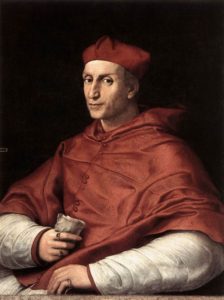
Cardinal Bernardo Dovizi De Bibbiena
One Uffizi loan is Raphael’s realistic Portrait of Pope Leo X with Two Cardinals (c.1517). Commissioned by the Pope himself and painted in Rome, it was a wedding present for his nephew Lorenzo, the Duke of Urbino who fathered Catherine who became Queen of France, and so the portrait ended up in the Uffizi. The cardinal on the left is the Pope’s nephew, Giuliano de’ Medici (future Pope Clement VII); the other is Cardinal Luigi de’ Rossi a maternal cousin. It was especially restored for “Raffaello” at the Opificio delle Pietre Dure in Florence. The other Uffizi paintings by Raphael are his “San Giovanni Battista”, “La Velata”, perhaps a portrait of Raphael’s great love Margherita Luti; a portrait of Cardinal Bernardo Dovizi de Bibbiena (1470-1520), a patron of Raphael, a close advisor to Pope Leo X and the uncle of Raphael’s official but not beloved fiancée; “Ezekiel’s Vision”, “Madonna del Granduca” and “Madonna dell’Impannata”, a portrait of wall-eyed Cardinal Tommaso Inghirami, “A Young Man with an Apple”, and one of his two self-portraits here, which is the logo of the exhibition.
Best-known for his Madonnas: three, all painted in Rome, are returning for the first time: Washington’s d’Alba (c. 1510), Capodimonte’s (Naples) of Divine Love (c. 1516), and the Prado’s of the Rose (1518-20). Also famous for his realistic portraits, the most famous of which is on loan from Rome’s Palazzo Barberini and depicts his beloved mistress, Margherita Luti, known as “La Fornarina” because her father was a baker.
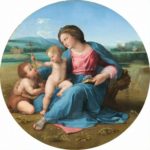
Alba Madonna
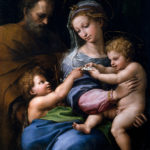
Madonna of the Rose

Madonna of Divine Love
However, “Raffaello 1483-1520” concentrates on the artist’s love of antiquity and of Rome, to which he owes his fame, thanks to his patrons Popes Julius II and Leo X, and their banker Agostino Chigi. The title’s inverted dates are intentional-a flashback of sorts. At the time of his death at only age 37 on Good Friday, Raphael was already a cult figure in Rome. He was venerated and it was commonly believed that his death on Good Friday was not a coincidence, but the will of God. He’d requested to be buried in the Pantheon, the temple to all the ancient gods before it became a Christian church. Hence the exhibition begins with two paintings of his tragic premature death: “Raphael’s Funeral” by Piero Vanni (1845-1905) and “Homage Paid to Raphael on his Deathbed” by Pierre-Nolesque Bergeret (1782-1863).
Next comes a reproduction of his tomb showing his epitaph. It was written by his friend Pietro Bembo (1470-1547), a Venetian scholar and humanist, who’d first met Raphael at the court of Urbino. The Latin text reads: “Here lies the famous Raphael, by whom Nature feared to be conquered while he lived, and when he was dying, feared herself to die.”
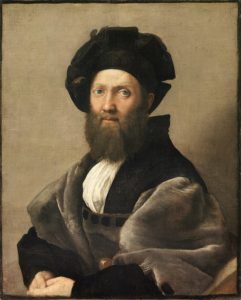
Baldassare Castiglione
The centerpiece of Room Two-not to mention the exhibition’s raison d’être-is Raphael’s letter, perhaps never sent, written with courtier, diplomat, soldier, author of The Book of the Courtier Baldassare Castiglione (1478-1529) in 1519 to Pope Leo X. The two close friends emphasize the importance of preserving the glory of ancient Rome and suggest contemporary Rome as the center of the world and art. Hence the rest of the exhibition concerns the direct influence of ancient Roman art on Raphael’s creations. Often ancient artifacts are juxtaposed for comparison with Raphael’s drawings and paintings. Clearly some of the ancient sculptures on display inspired the figures in his paintings, like the head of Isis and Santa Cecilia or Antinuous and Jonah.
Generally speaking the ten rooms of “Raffaello 1520-1483” follow a retrospective chronological order. The highlights in Rooms 4 and 5 are his religious works; Room 6 his portraits: Room 7 his architectural drawings especially those of the Pantheon and of St. Peter’s Basilica; and Rooms 8-10 his pre-Rome works. The earliest of these, an ink drawing of a hand holding a pen and the face of a boy, perhaps his own, dates to 1497-9.

“La Fornarina”
The 544-page catalog with 464 colored photographs, published by Skira in Italian and in English editions, costs 46 euros.
Rome is the perfect location for this mega-show because many of Raphael’s greatest works are frescoes and thus not transportable not to mention the ancient ruins that he so loved. Therefore after visits to “Raffaello 1520-1483”, his frescoed Rooms, paintings, and Loggia in the Vatican Museums and St. Peter’s, wander in the various fora and Nero’s Golden House on the Oppian Hill; pay him homage at his grave in the Pantheon; admire his architecture in the Chigi funerary Chapel of Santa Maria del Popolo and in the Church of Sant’Eligio degli Orefici; and his Sybil fresco in a chapel of the church Santa Maria della Pace and his Prophet Isaiah in the Basilica of Sant’Agostino, both near Piazza Navona and especially his many frescoes in Chigi’s Villa Farnesina in Trastevere.
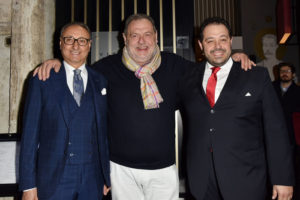
Business partner Domenico Iozzi, Gianfranco Vissani, and his son Luca Vissani
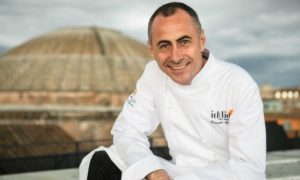
Francesco Apreda: La Repubblica
Where to eat on your wanderings: Nearby the Farnesina Romolo, at Via di Porta Settimiana 8, is the site of Raphael’s love trysts with “La Fornarina”. House specialties: cacio e pepe, all’amatriciana, carbonara, trippa, coda alla vaccinara, and saltimbocca. Near the fora and Nero’s Golden House stop for homecooking at family-run Hostaria da Nerone. Near Santa Maria del Popolo I can highly recommend the bollito, a selection of boiled meats and condiments at “Dal Bolognese”, where celebrities go to be seen. You can’t go wrong across the piazza at Le Jardin de Russie in the deluxe Hotel La Russie owned by Rocco Forte. Near Piazza Navona there’s pluri-starred chef Gianfranco Vissani’s new venture, ”Il Tuo Vissani”, which just opened on February 27 with snacks and meals all day. Overlooking the Pantheon for a very special meal head to rooftop “Idylio by Apreda” in the 5-star Pantheon Iconic Rome Hotel. Only six months after opening last year Neapolitan Chef Francesco Apreda, formerly Executive Chef at Imagò, the rooftop restaurant in the deluxe Hassler Hotel at the top of the Spanish Steps, was awarded a Michelin star. You can order à la carte or choose between three tasting menus: “Inside the Pantheon” or Rome through Apreda’s eyes (120 euros), “Iconic Signature by Apreda” (140 euros), a journey through Apreda’s experience of gourmet dishes from around the world, or “Seasons at the Pantheon” (160 euros).
After this full-immersion experience one can’t help but wonder what this architect, draughtsman, painter, poet, archeologist, who died of mysterious causes, most likely exhaustion or syphilis, might have accomplished had he lived Leonardo’s 67 or Michelangelo’s 89 years. To learn more about this genius who never married, his loves, and his life in Rome, enjoy the historical novel, The Ruby Ring by Diane Haeger.
